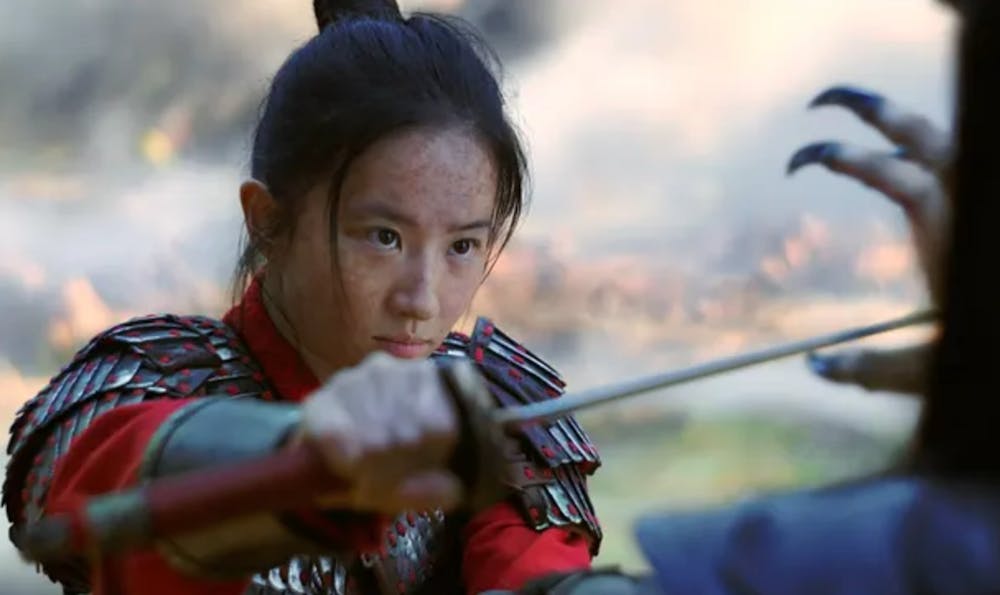Disney’s 2020 Mulan once again reveals the futility of trying to adapt the magic of animation to live–action.
The mark of a good adaptation is not how close it is to the original (looking at you, The Lion King), but how it transforms the original work to say something new and interesting. The creators of Mulan apparently decided to only make changes that would serve to tell a dull, boring story.
Most people I know, especially women of color, have incredibly fond memories of the animated Mulan. The songs are still some of Disney’s best—and it was the first Disney princess movie to not only star a princess of color, but also to have an active, physical role that didn’t eventually require rescue by a prince. It’s still my favorite Disney film.
The live–action adaptation removed everything that made the animated film so memorable, charming, and fun. Since the film is presumably meant for younger audiences, it’s baffling that the iconic songs and humorous, magical characters, like the cricket and Mushu, were taken out. I really felt the loss of the music, which contributed immensely to the emotional foundation of the original movie.
Even worse, Mulan is no longer a relatable heroine who enters the war to protect her father. Instead, the movie insists that she’s special—that she’s not like other girls. She’s a tomboy who was a precocious fighter as a child, exhibiting classic #girlboss behavior. The story relies on a half–baked, under–researched plot point of Mulan having a "very strong chi" that makes her an unbelievably adept fighter. Where is the protagonist’s struggle, or the iconic training montage of Mulan using her intelligence and determination to become a fighter?
The 2020 version of Mulan isn’t relatable or likable. She was born special and strong, which makes her boring. Even when she’s revealed to be a woman, she walks out with her head held high amidst perfectly–falling snow, her stunning hair blowing behind her. Everything in the film looks too clean and shiny, taking away from the fact that a war is taking place. Without Mushu or charming animated sequences, Mulan never develops a personality that makes you want to root for her. Even her interactions with the other men, including her new bland love interest, seem forced.
In contrast, the animated Mulan emphasizes the horrors of war as well as it can while still appealing to a demographic of children. The scene of soldiers stumbling into a village burned to the ground, with only a child’s doll left on the smoldering ground, is genuinely horrifying. Mulan herself is interesting and lovable: animation lends her an expressive, charming face. The songs reveal her inner thoughts and conflicts with her identity as a woman surrounded by men. Her relationships with her family, animal sidekicks, and Li Shang make her a multi–dimensional character.
The animated movie trusts its audiences to draw their own conclusions about systemic misogyny in the setting and narrative. Mulan does so much for her platoon, only to be exposed before them and expelled from the army. In contrast, the live–action version introduces a second female character, a witch on the side of the bad guys, who also feels excluded from a patriarchal society. The introduction of witches and magic makes the plot seem ridiculous. The character serves only as a blunt reminder about the misogynistic themes of the film, taking up runtime that could've been used for Mulan’s character development. Overall, the adaptation is boring, and a thorough disappointment to the memory and poignancy of the original.
Though many may be unfamiliar with it, there is another prominent live–action film about the Fa Mulan legend: the 2009 Chinese film Hua Mulan, also known as Mulan: Rise of a Warrior. This is not only a superior adaptation, but a far better and more enjoyable cinematic experience. While this film also takes a similarly serious approach to that of Disney's live–action version, it actually succeeds in showing the true horrors of war instead of just creating a glorified action film.
Mulan: Rise of a Warrior begins by showing its antagonist massacring prisoners of war, immediately establishing the high stakes and horror inherent in such a conflict. The film as a whole is darker and grittier, seeming far more real. It is emotionally devastating from beginning to end. So many endearing characters die and suffer, get trapped without supplies, or are betrayed by their commanders. There is no one–action victory where Mulan can just save the emperor to gain acceptance and glory.
Mulan in Rise of a Warrior is intelligent and strategic, but though she knows how to fight, she has much to learn about how to succeed in battle and lead troops. She is established as a down–to–earth protagonist you want to root for. The movie follows her as a regular person with the courage to get through a war trying to rob her of her humanity. She visibly suffers, grieves, loves, and sacrifices, all of which make her more relatable. She carriers her emotions and trauma back home, and the film has a bittersweet ending that emphasizes how much she has lost and how much she has grown.
It is baffling how, with basically the same run time and a fraction of the budget, the 2009 film is a more poignant, emotional, and grounded film than the Disney version. If the 2020 film fails, I hope future Disney projects that seek to incorporate diversity won’t feel the consequences. Should you want to watch a live–action version of Mulan’s story, watch Mulan: Rise of a Warrior. Be ready to cry, and don’t bring kids.

